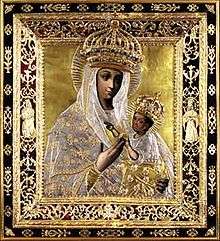Our Lady of Budslau
Our Lady of Budslau is one of the most renowned Catholic icons of Belarus. It can be found in the Church of the Assumption of the Blessed Virgin Mary in the village of Budslau.[1] The main celebration of icon takes place on July 2. On November 28, 2018, this annual celebration in honor Our Lady of Budslau was added to the List of the Intangible Cultural Heritage by UNESCO.[2][3]

History
The icon was painted by an unknown artist in the 16th century. It was a present to Voivode of Minsk Jan Dominikowicz Pac by Pope Clement VIII to honor his conversion from Calvinism into Catholicism in 1598. Pac treasured the icon and kept it at the Pac Palace in Vilnius. After the death of Pac, the icon has passed to chaplain Isaac Skalai who brought it to Daŭhinava. In 1613, Skalai gifted it to the Bernardine monastery in Budslav.
The icon was known for miraculous healings that were described in the book of the abbot E. Zyalevich Zodiac on the earth (1650). In 1635, Our Lady of Budslau was moved to the main altar in place of the visitation icon. The first miracle was recorded in 1617 – curing blindness of the five-year-old Jehoshaphat Tyszkiewicz, who later became a known Carmelite priest. On the same day Reginald Tyszkiewicz was cured of epilepsy, which had plagued him for seven years. Zyalevich described 42 miraculous recoveries and an episode with Ian Vronsky, captain serving Janusz Kiszka, Grand Hetman and Voivode of Polock. The wounded captain was captured by the Tsardom of Russia in 1632 but was able to safely return because of a vow in front of the icon, which belonged to his friend Lukas Vladovsky. Perhaps that was the reason why Janusz Kiszka became one of the sponsors of the stone church in 1633–1643. A riza was added to the icon in the 1st half of the 17th century.
In 1643, the master of Polotsk Andrew Kromer built the Church of the Assumption of the Blessed Virgin Mary, for which Peter Gramel created a unique wooden altar, and where the icon was placed. During the Russo-Polish War (1654–1667), the icon was temporarily evacuated to the town of Sokółka (Bialystok). Bernardines promoted the cult of the icon, and made reprints of it from the beginning of the 19th century. After the monastery was closed by the Tsarist authorities in 1859, the popularity of the icon has decreased. However, in the Catalog of the Diocese of Vilna, Budslau was included among the ten churches with miraculous icons of Our Lady.
After the dissolution of the Soviet Union, the cult of the icon recovered. Starting in 1990, an annual pilgrimage takes place on July 2. In 1991–1992, the icon was restored by Loukachevitch. On July 2, 1996, the papal nuncio Archbishop Dominik Hrušovský delivered the papal message announcing Our Lady of Budslau as the patroness of the Roman Catholic Archdiocese of Minsk-Mohilev. Generally, the icon is also regarded as the patroness of Belarus. On 2 July 1998, the icon was crowned with papal crowns by Cardinal Kazimierz Świątek.
References
- Alexander Yaroshevich. Budslau icon of Our Lady // Template:Sources/EVKL С. 353
- "Celebration in honor of the Budslaŭ icon of Our Lady (Budslaŭ fest)". UNESCO. 2018. Retrieved 2018-11-28.
- "UNESCO has included Budslau Festival of the Intangible Cultural Heritage". Nasha Niva. 2018-11-28. Retrieved 2018-11-28.
External links
| Wikimedia Commons has media related to Category:Budslaŭskaja. |